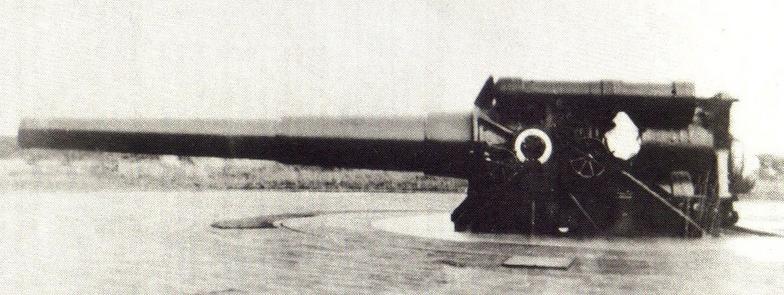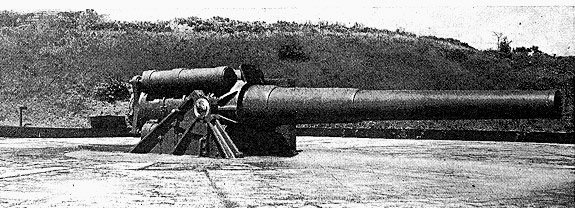Fort Saulsbury, DE
Delaware's Forgotten Fort
This page is about the guns at Fort Saulsbury
Fort Saulsbury was a coastal defense artillery site with four fixed 12 inch guns assigned. Each of the two batteries had two guns with one gun mounted on each end of the bunkers. The M1895 guns were mounted on M1917 Barbette Carriages that allowed adjustments in elevation and azimuth. At the time, there were a number of these guns in use for the defense of the U.S. coastal areas and some were used for other defenses primarily in the Pacific Region. After World War II, the guns were demilitarized and melted down as scrap. The only known remaining examples of the M1895 guns that exist today are located on the Island of Corregidor in the Philippines.
In order to represent the guns with the most detail, not all pictures are from Fort Saulsbury. If the location of the gun is known, I have applied the two letter state code to the picture. The ones marked DE are Ft. Saulsbury guns. If there is a question, I used ?? as an unknown. For the guns in Corregidor, I used CP. Pictures of the Ft. Saulsbury guns seem to be rare. My guess is that there are more pictures that exist probably taken by those that served at the fort or perhaps curious visitors. They are probably in a box somewhere in a drawer. The real fear is that they were discarded by family members not knowing what the old pictures were.
DE
CP
Gun elevated in a firing position
Gun lowered for servicing and loading
DE
DE
Here are two pictures with the barrels lowered and the canvas cover over the breach mechanism for weather protection. It is believed that this is gun number 2 of Battery Hall. The little girl in picture at right is unidentified.
DE
CA
It is believed that the youngster at right is Robert Field who was the son of the person in charge of the fort. He went on an had a illustrious highly decorated military career himself.
In a word; FIREPOWER!
TX.
The breech end on an M1985
The "business" end of the 12 inch barrel
TX
********************************************************
The shells were stored in the bunker portion of the battery on racks as shown. Within the bunker, the shells were transported using an overhead trolley system using a chain hoist. The rollers of the trolley used the "I" beams as a track.
When outside, the 1,100 pound shells had to be placed on a three wheeled cart for transporting to the guns.
??
Re-enactor Sgt. Resch demonstrates how shells were transported inside at Fort Miles, DE.
There were four bags of powder needed to propel the 1,100 pound shell. The powder weighed 279 pounds.
CA
NJ
GROUND LEVEL_________________________________________
Cut away view showing gun above grade and carriage below grade. Gun positioning could also be controlled on lower level.
CP
CP
The above pictures show two views of a gun in Corregidor. The top view shows a close-up of the breech while both views show the recoil cylinders very well. There are four on these cylinders per gun that helped to dampen the gun's massive re-coil. The cylinders contained a series of large springs and was filled with hydraulic fluid. Notice the thickness of steel holding the cylinder rods.
DE
DE
This is a picture of Battery Hall's gun number 2. The gun is pointed inland. The CCC camp was located on our family's farm about 2.5 miles from Fort Saulsbury.
Many of the soldiers that served at Fort Saulsbury were local residents. There will be more about this under the "WW2 Era" Tab.
CA
These are copies of the inventory control cards used by the Army. For the Battery Hall guns in left picutre, you can see where the guns were delivered from the factory in July 1917. You can also see where they were process for salvaging in May 1946. For the Battery Haslett guns, they were installed at the same time, but then transferred to Fort Miles during WW2. Those guns became the guns for the new Battery 519 at Fort Miles.
Required number of crew per gun: 48
Gun Section Chief: 1
Gun Squad: 28
Ammunition Squad: 19
DE?
DE
DE.
Some of the gun details:
CP
For additional information, be sure to watch the training film under the "Filming" tab. The films were done at Fort Saulsbury for use by the Army to train gun crews worldwide. There are a couple of notable scenes in the training film number 4 of 8. In the opening segment, the gun barrel is raised to point directly at the camera. If you check, it is gun barrel is # 52 which matches the inventory card. You can also see how shells were delivered by truck and off loaded using the overhead trolley system described above. The film shows the truck entering the fort with inside scenes of the fort as well.
Supporting the guns
Here is a great example of a "shell cart." It was constructed from original plans and is on display in Battery 519 at Fort Miles. At Fort Saulsbury, where the guns were located outside, the cart was used to transport the shells from storage to the gun chamber. The shell was loaded on the cart using the overhead lifting system that was in the shell storage room. The cart was then pushed outside to the gun. The shell trough was indexed to the gun and then the shell was pushed forward to load the gun.
There was somewhat of a similar device (without wheels) used to transport the bags of powder and to load the charge into the gun. It was a wooden trough designed for the task.
Range of Guns: 18 miles Gun Bore: 12 inch
Weight of Shell: 1070 lbs. Powder Charge: 279 lbs.
Max. Rate of Fire: 1 round per minute
This display sample represents the four bags of powder needed to launch the projectile. Each bag weigh 69.75 pounds for a total weight of 279 pounds.
Picture to be added.
This is a picture taken at Fort Saulsbury for the training films. (See "Filming" tab) It shows several items about the fort if you look closely. It shows the three wheeled shell cart being rolled out of the South entrance of Battery Hall. Picture is taken looking North into the fort with the entrance door open. The 12" shell is seen on the cart en-route to the gun #1 of Battery Hall. Also one can see the powder charge on the cart (white bags). At the top of the green bar is the indexing cushioning stop when the shell cart aligns with the gun breech for loading so that the cart does not impact breech of gun.
Here are two pictures of gun number 1 of Battery Hall.
This picture clearly shows the shell cart aligned with gun for loading. Notice the heavy plate at floor level that is used in aligning of the cart. First, two large wheels move forward on either side of the plate. The small center wheel has a slot to accept the wheel. The alignment bar also uses the same slot followed by the wheel. During rapid reloading the indexing plate assures perfect alignment of shell cart..





































